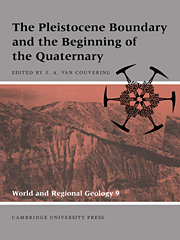Book contents
- Frontmatter
- Contents
- List of contributors
- Preface: the new Pleistocene
- Foreword
- Part I Definition of the base of the Quaternary
- Part II Characterization of the Pleistocene boundary-stratotype
- Part III The paleontological context of the Pleistocene boundary
- Part IV The Pleistocene boundary in regional sequences
- 11 The Pliocene–Pleistocene boundary in Italy
- 12 Stratigraphy of the Plio–Pleistocene sequence of the Mediterranean coastal belt of Israel and its implications for the evolution of the Nile Cone
- 13 The Pliocene–Pleistocene transition in the Iberian Peninsula
- 14 Biostratigraphy and calibrated climatic chronology of the Upper Pliocene and Lower Pleistocene of France
- 15 The Plio–Pleistocene of England and Iceland
- 16 The Neogene–Ouaternary boundary in The Netherlands
- 17 The Tertiary–Quaternary boundary in western Germany
- 18 The Pliocene–Pleistocene boundary in eastern Germany
- 19 The Plio–Pleistocene of Hungary
- 20 The Pliocene–Pleistocene boundary in Romania
- 21 The Pliocene and Pleistocene of the European part of the Commonwealth of Independent States
- 22 The N/Q boundary in Asian Russia and Tadjikistan
- 23 The Pliocene–Pleistocene boundary in the Indian subcontinent
- 24 The Pliocene–Pleistocene boundary in Japan: the Osaka Group, Kinki district
- 25 The Pliocene–Pleistocene boundary in Japan: stratigraphy in the Boso Peninsula, central Japan
- 26 The base of the Quaternary in China
- 27 Plio–Pleistocene deposits and the Quaternary boundary in sub-Saharan Africa
- 28 Plio–Pleistocene reference sections in Indonesia
- 29 The Pliocene–Pleistocene boundary in New Zealand
- 30 The Pliocene–Pleistocene boundary in continental sequences of North America
- Index
15 - The Plio–Pleistocene of England and Iceland
Published online by Cambridge University Press: 10 November 2009
- Frontmatter
- Contents
- List of contributors
- Preface: the new Pleistocene
- Foreword
- Part I Definition of the base of the Quaternary
- Part II Characterization of the Pleistocene boundary-stratotype
- Part III The paleontological context of the Pleistocene boundary
- Part IV The Pleistocene boundary in regional sequences
- 11 The Pliocene–Pleistocene boundary in Italy
- 12 Stratigraphy of the Plio–Pleistocene sequence of the Mediterranean coastal belt of Israel and its implications for the evolution of the Nile Cone
- 13 The Pliocene–Pleistocene transition in the Iberian Peninsula
- 14 Biostratigraphy and calibrated climatic chronology of the Upper Pliocene and Lower Pleistocene of France
- 15 The Plio–Pleistocene of England and Iceland
- 16 The Neogene–Ouaternary boundary in The Netherlands
- 17 The Tertiary–Quaternary boundary in western Germany
- 18 The Pliocene–Pleistocene boundary in eastern Germany
- 19 The Plio–Pleistocene of Hungary
- 20 The Pliocene–Pleistocene boundary in Romania
- 21 The Pliocene and Pleistocene of the European part of the Commonwealth of Independent States
- 22 The N/Q boundary in Asian Russia and Tadjikistan
- 23 The Pliocene–Pleistocene boundary in the Indian subcontinent
- 24 The Pliocene–Pleistocene boundary in Japan: the Osaka Group, Kinki district
- 25 The Pliocene–Pleistocene boundary in Japan: stratigraphy in the Boso Peninsula, central Japan
- 26 The base of the Quaternary in China
- 27 Plio–Pleistocene deposits and the Quaternary boundary in sub-Saharan Africa
- 28 Plio–Pleistocene reference sections in Indonesia
- 29 The Pliocene–Pleistocene boundary in New Zealand
- 30 The Pliocene–Pleistocene boundary in continental sequences of North America
- Index
Summary
Plio–Pleistocene in England
The so-called Crag formations of East Anglia are the only British examples of a sedimentary sequence that is partly Pliocene and partly early Pleistocene. They are composed of marine near-shore and estuarine shelly sands and clays, in some horizons with good pollen assemblages. The oldest unit, the Coralline Crag, has always been accepted as Pliocene. Early attempts to locate the base of the Pleistocene in that sequence were guided by the belief that its position would be indicated by evidence of a sharp drop in temperature. Thus, at the International Geological Congress in 1948, it was recommended (King and Oakley, 1949) that in England the Neogene–Quaternary boundary should be placed in the East Anglian sequence at the base of the Butleyan Red Crag, the highest and youngest of Harmer's (1902) three Red Crag “zones.” A number of authors (e.g., Boswell, 1952) subsequently proposed that it should be lowered to the base of the Red Crag, on the assumption that the transition from the underlying Coralline Crag indicated a major climatic deterioration. On the premise that the boundary was associated with the Olduvai normal paleomagnetic event, Hey (1977) and Funnell (1977) independently concluded that in East Anglia it could lie above the top of the Red Crag.
It must be emphasized that the paleomagnetic data available from the East Anglian succession are scanty (Van Montfrans, 1971, pp. 100–101), and materials suitable for radiometric dating appear to be absent.
- Type
- Chapter
- Information
- The Pleistocene Boundary and the Beginning of the Quaternary , pp. 183 - 184Publisher: Cambridge University PressPrint publication year: 1996



